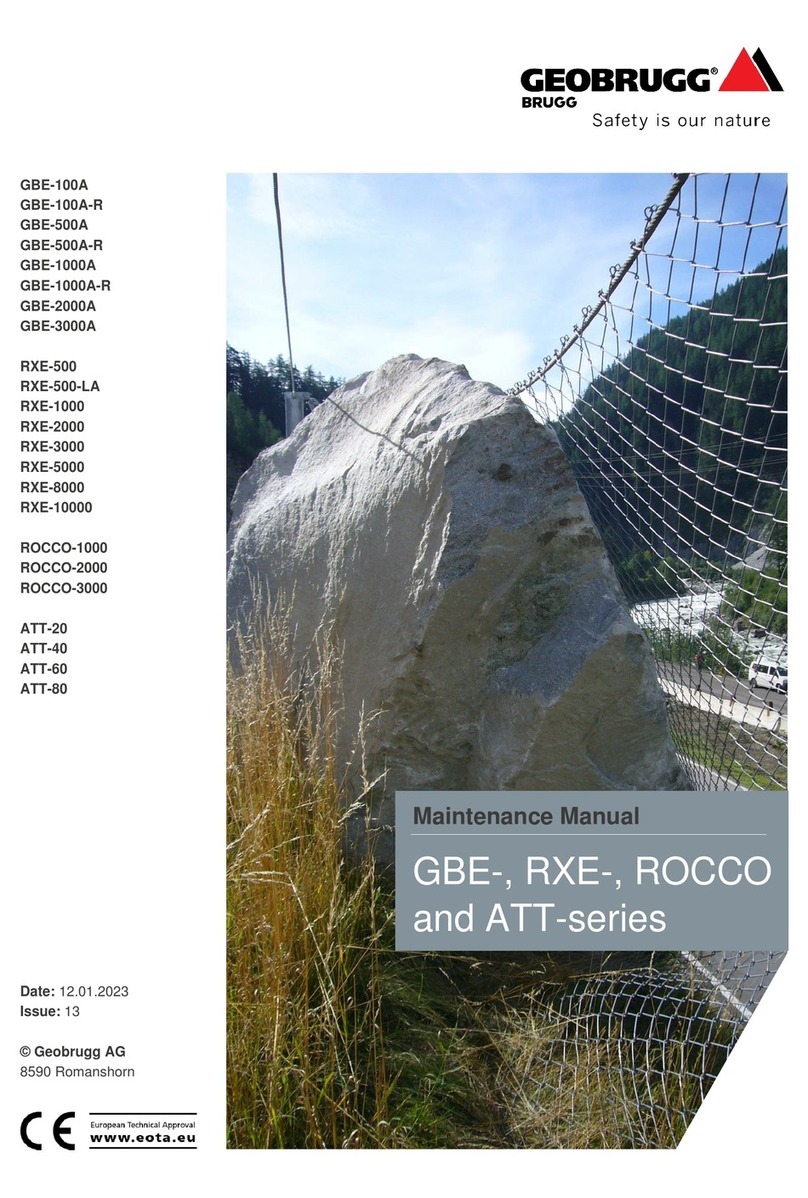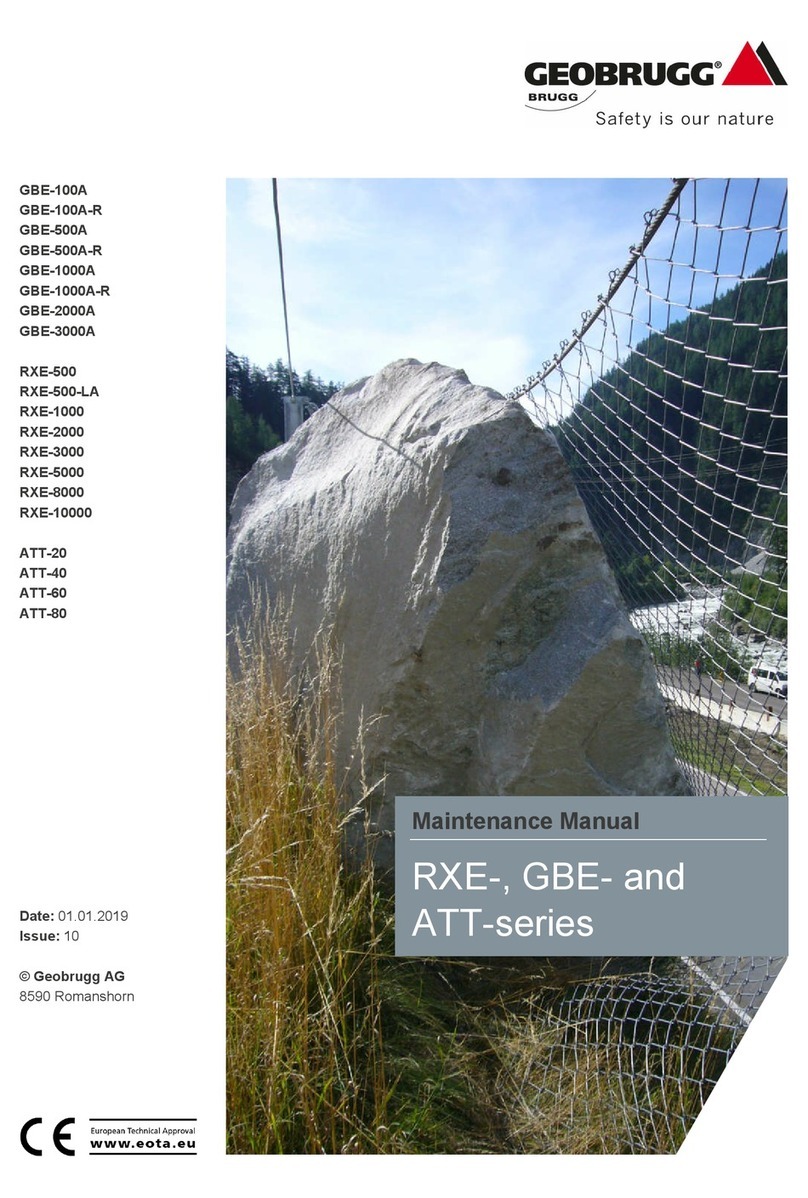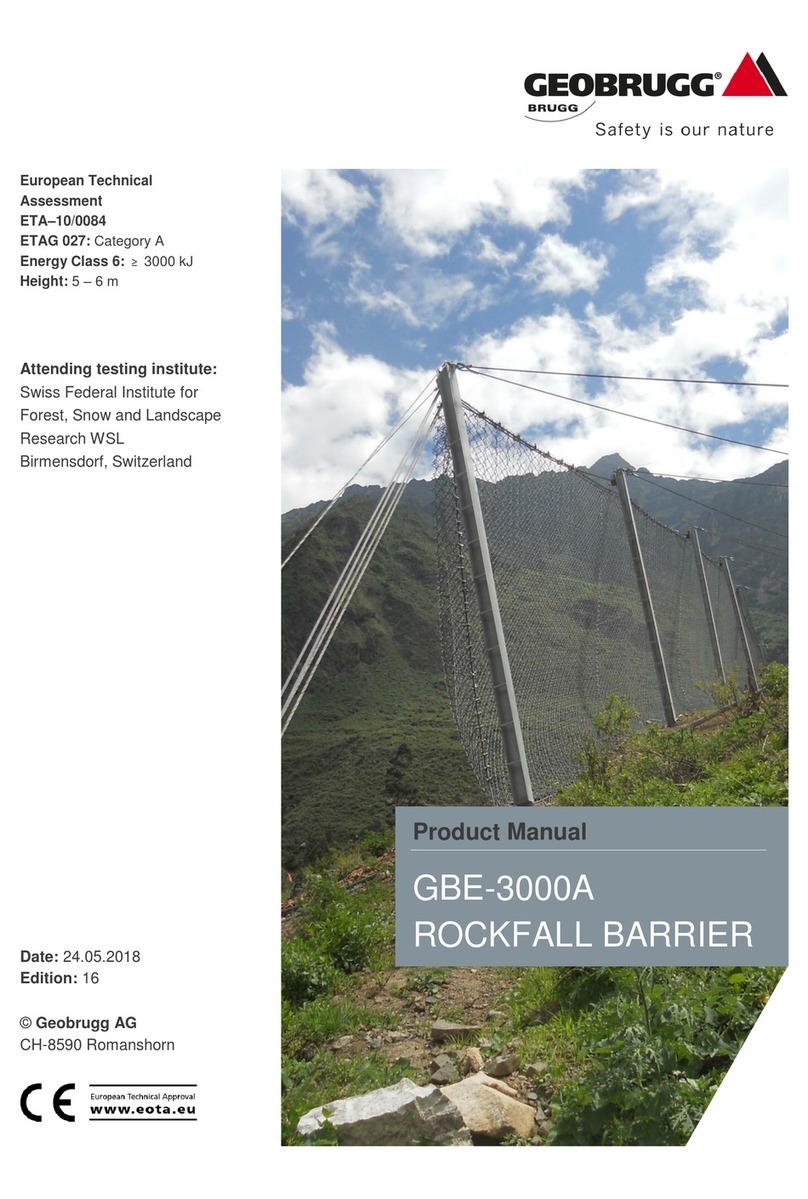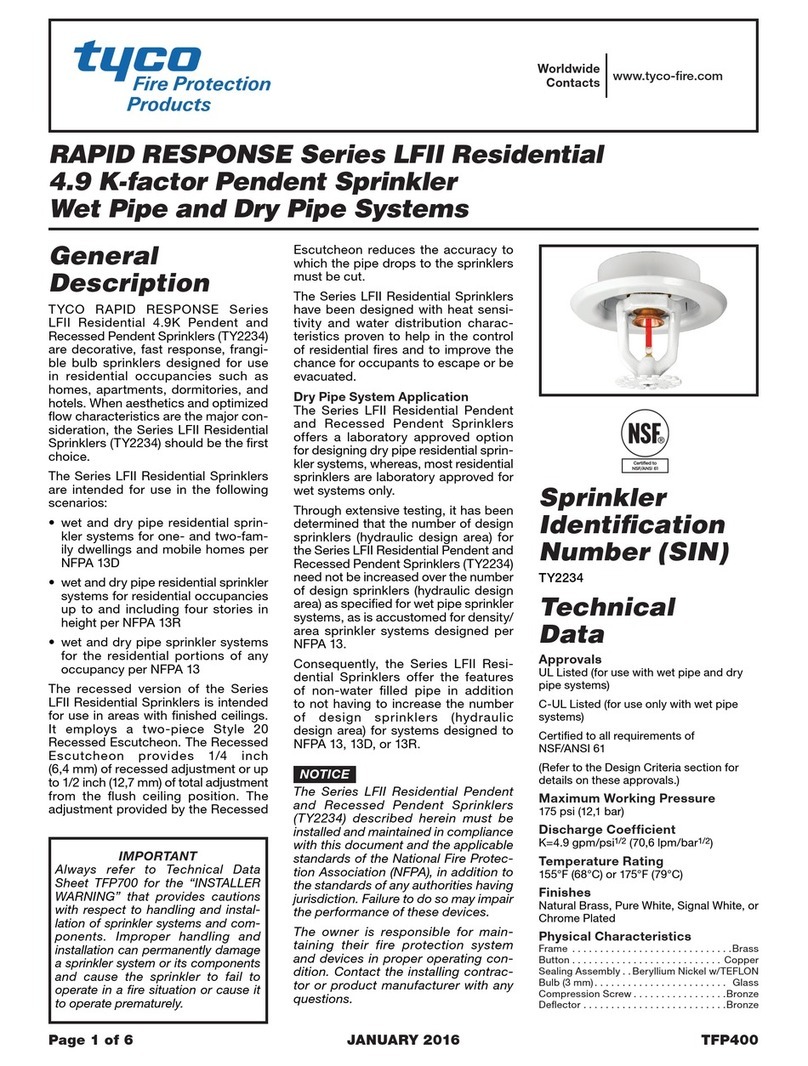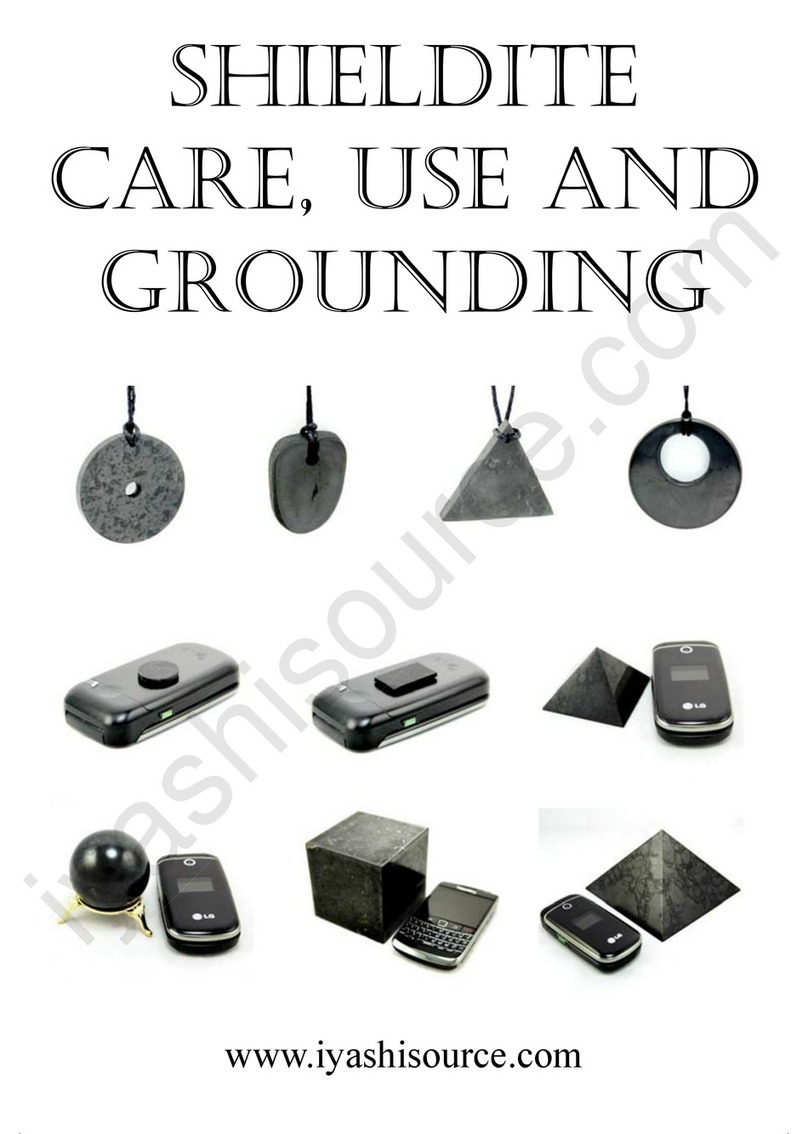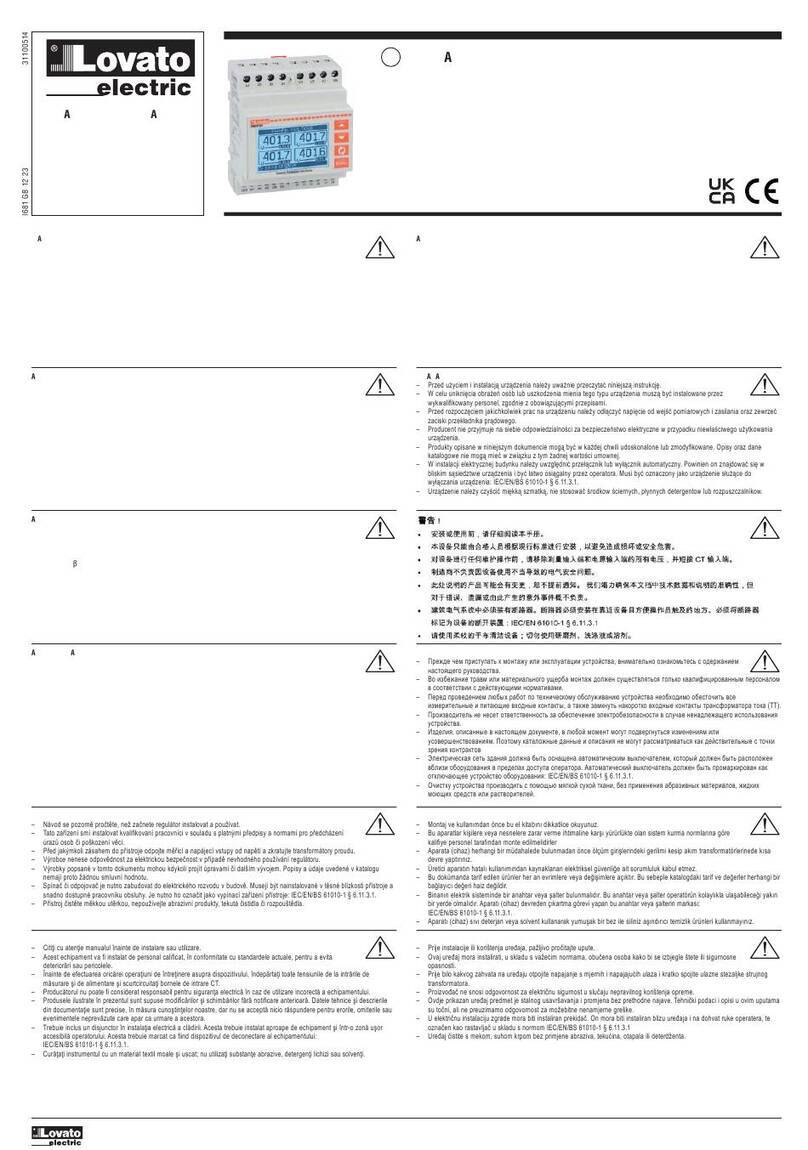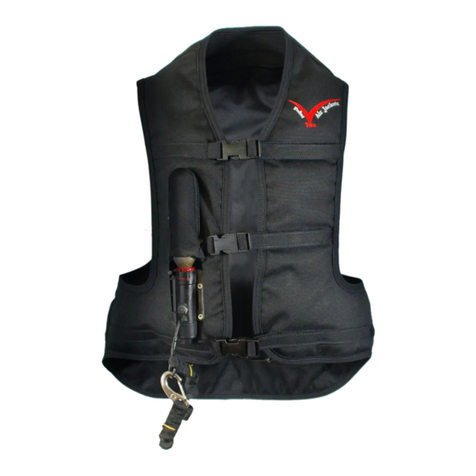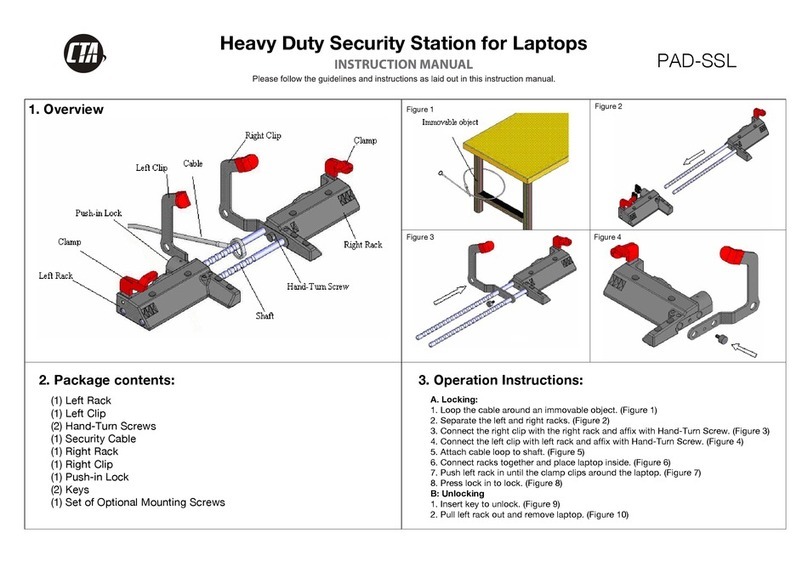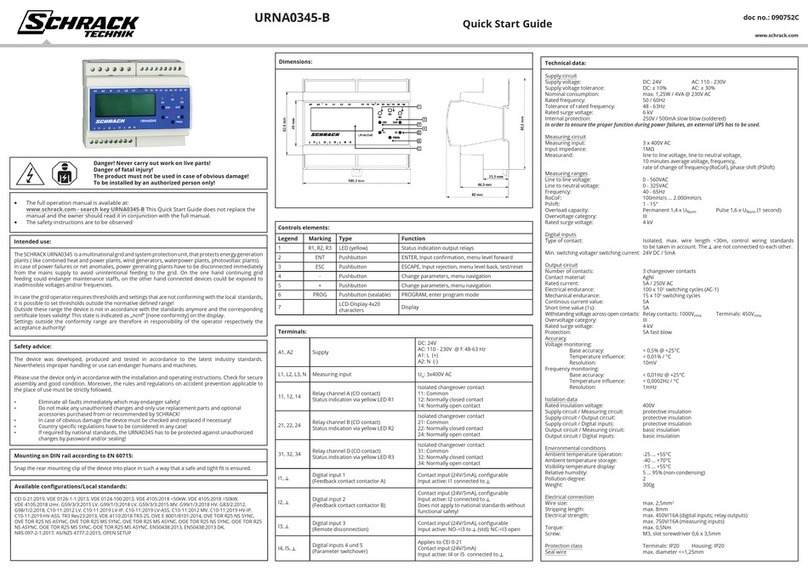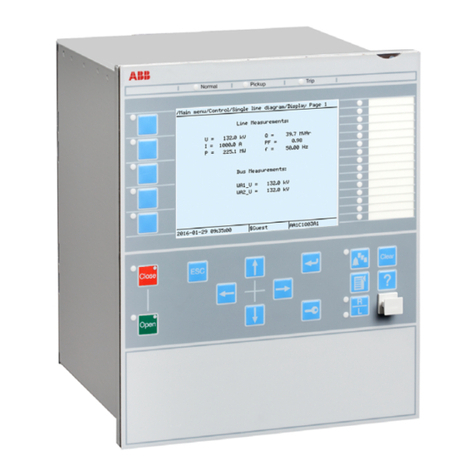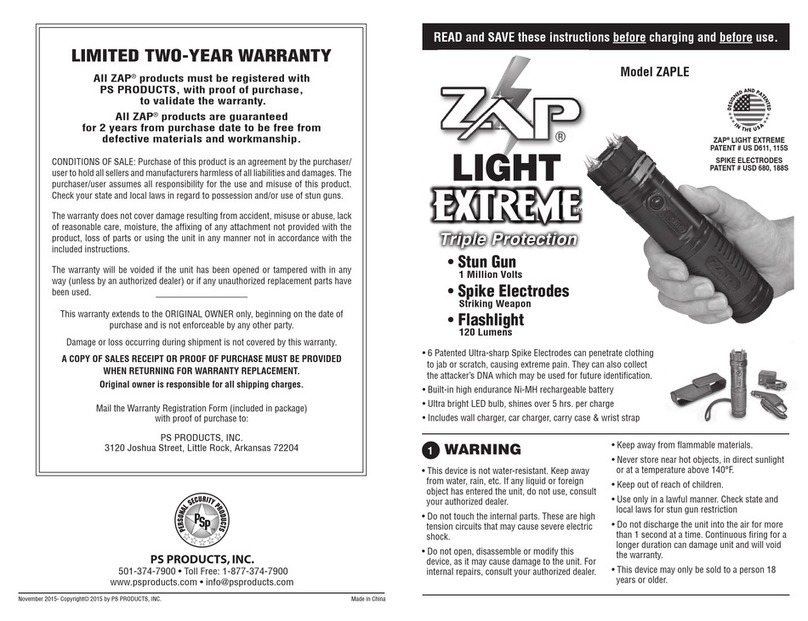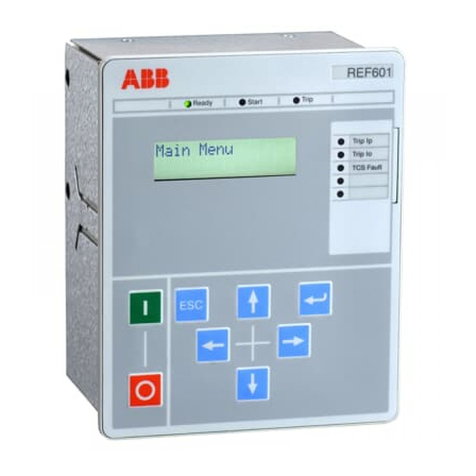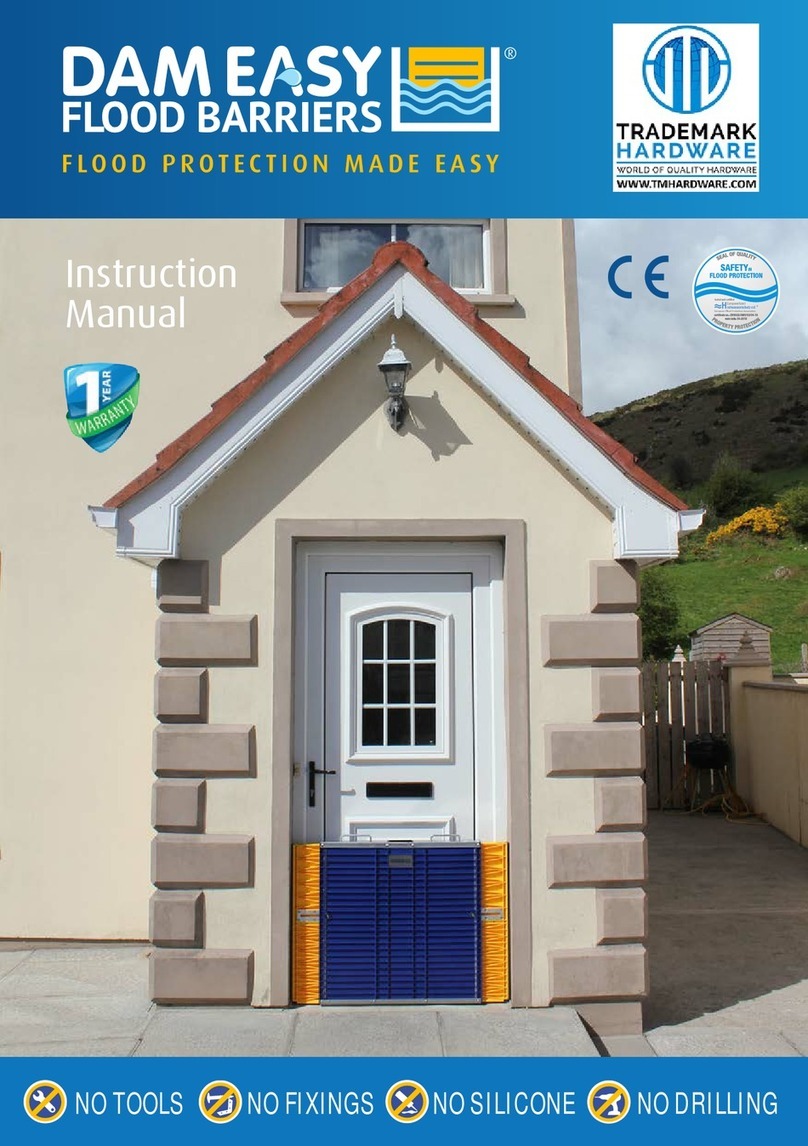Geobrugg RXE-2000 User manual

European Technical
Assessment: ETA 13/1047
Date: 28.02.2019
Edition: 11
© Geobrugg AG
8590 Romanshorn,
Switzerland
Product Manual
RXE-2000
ROCKFALL BARRIER

Page 2/60
© Geobrugg AG, Switzerland RXE-2000 / 11
FUNCTION AND STRUCTURE OF THE MANUAL
This system manual ensures that Geobrugg rockfall protection systems are manufactured without errors in ac-
cordance with the latest technical findings, that their area of application is clearly defined, that their functionality is
guaranteed, and that their installation is performed and checked properly.
The system manual is divided into the following parts:
Proof of quality assurance
Staking out
Assembly details
System overview/rope guide
ISO 9001 certificate
This document does not claim to be exhaustive. It is designed for general, standard applications and does not
take any project-specific parameters into account. Geobrugg cannot be held liable for any additional costs which,
may arise in special cases. If anything is unclear, please contact the manufacturer. Geobrugg AG's general terms
and conditions apply.
RESPONSIBILITY FOR THE CONTENT:
Geobrugg AG
Schutzsysteme
Aachstrasse 11
Postfach
8590 Romanshorn, Switzerland
www.geobrugg.com
Romanshorn, 28.02.2019
(Stamp/legal signatures)

Page 3/60
© Geobrugg AG, Switzerland RXE-2000 / 11
I AREA OF APPLICATION
Rockfall protection systems are planned based on detailed research carried out by specialist engineering compa-
nies, which take the following geotechnical aspects into account and define the area of application accordingly:
Previous rockfall events
Condition of the rockfall outbreak zone
Assessment of the stability of the entire rockfall zone
Frequency of rockfalls
Size of the rocks collected
Trajectories and displacements of the rocks
Kinetic energy calculations
Positioning of the barrier (taking the local topography into account)
Anchoring conditions
II QUALITY OF THE SYSTEM COMPONENTS
Geobrugg AG, formerly the Geobrugg Schutzsysteme (Geobrugg Protection Systems) department of Fatzer AG,
Romanshorn, has been certified according to the quality management system requirements (ISO 9001:2008) un-
der the registration number CH-34372 since August 22nd, 1995. The certification center is the SQS (Swiss Asso-
ciation for Quality and Management Systems), which is a member of IQNet. The quality manual specifies in full
the way in which the individual system components (basic material, commercial products, and end products) are
checked extensively to eliminate poor quality. You can find the corresponding certificates in the appendix.
III FUNCTIONALITY OF THE BARRIER SYSTEMS
The system functionality is based on rockfall tests that replicate real-life conditions, performed in Walenstadt
(SG), Switzerland, in accordance with the European Guideline ETAG 027 “Falling Rock Protection Kits” and the
Swiss guideline for type-testing rockfall protection kits. In the rockfall tests under real-life conditions, the rocks are
thrown vertically into the central field of a three-field barrier with a 10 m distance between the posts of each field.
An impact speed of at least 25 m/s is achieved. These investigations are inspected by notified testing centers and
obtain European approval, known as ETA (European Technical Assessment), as well as a Swiss inspection certif-
icate from the Federal Office for the Environment (FOEN). The current system, RXE-2000, has the assessment
no. ETA – 13/1047 and the test certificate no. S 13-2.
IV QUALITY CONTROL FOR INSTALLATION
This system manual describes the planning and installation of the barriers in detail.

Page 4/60
© Geobrugg AG, Switzerland RXE-2000 / 11
V PRODUCT LIABILITY
Rockfall, slipping, landslides, and avalanches occur sporadically and cannot be predicted. Causes range from
human activity (building work, etc.) right through to force majeure (weather, earthquakes, etc.). Due to the wide
variety of triggers for these events, it is not possible to develop a scientific approach that will guarantee the safety
of persons and property.
However, the risk of injury and loss of property can be significantly reduced by applying appropriate engineering
calculations using foreseeable parameters and by creating proper protection measures accordingly in specific risk
areas.
These systems must be monitored and maintained to ensure the required level of safety. This level of safety can
also be diminished through incidents, natural disasters, insufficient dimensioning, failure to use standard compo-
nents, systems, or original parts, and corrosion (caused by environmental pollution, other human factors, or other
external influences).
As a contrast to the rockfall tests under real-life conditions – which test a very tough load but only illustrate a
standardized situation – very different barrier arrangements and designs may arise in the field as a result of to-
pography. The impact of these modifications and adjustments cannot always be determined exactly. Critical
points include the distance between posts, changes in direction, the installation angles of the rope anchors, the
angle of impact, and the speed of impact.
Geobrugg can provide assistance when you are assessing the influence of significant anomalies and special situ-
ations and offer suggestions for feasible solutions. However, Geobrugg cannot guarantee consistent performance
of the type demonstrated in the rockfall tests under real-life conditions. In critical cases, it is advisable to reinforce
individual components against the standard barrier.

Page 5/60
© Geobrugg AG, Switzerland RXE-2000 / 11
CONTENTS
1 HAZARD NOTES ................................................................................................................ 6
2 TOOLS FOR INSTALLING ROCKFALL BARRIERS ............................................................. 7
3 USING THE WIRE ROPE CLIPS ......................................................................................... 8
4 STAKING-OUT IN ACCORDANCE WITH THE TERRAIN ................................................... 10
5 STAKING-OUT GEOMETRY ............................................................................................. 12
6 INSTALLING THE ROPE ANCHOR ................................................................................... 16
7 ANCHORING THE BASE PLATE ...................................................................................... 18
8 PREPARING THE NETS AND POSTS ............................................................................... 20
9 CRANE OR HELICOPTER ASSEMBLY ............................................................................. 26
10 SUPERSTRUCTURE INSTALLATION STEPS ................................................................... 27
11 ASSEMBLY DETAILS ....................................................................................................... 33
12 SUPPORT ROPE SEPARATION WITH INTERMEDIATE ANCHORING .............................. 49
12 SPECIAL SOLUTIONS IN ADDITION TO THE STANDARD SOLUTION............................. 56
13 FINAL CHECK .................................................................................................................. 57

Page 6/60
© Geobrugg AG, Switzerland RXE-2000 / 11
EXPLANATIONS OF THE SYMBOLS USED
Safety note: Must be followed
Note/reminder that will help you to install the system easily and correctly
Consultation with Geobrugg is recommended
Upslope
Downslope
1 HAZARD NOTES
QUALIFICATION OF THE GROUP LEADER
Only a qualified group leader may be put in charge of the installation.
TENSIONED ROPES
Ropes will be tensioned. When installing and pretensioning ropes, ensure that there are no persons with-
in in the danger area.
RELEASING TENSIONED PARTS
Releasing or separating tensioned parts should be avoided wherever possible. If this is necessary, how-
ever, please exercise the utmost caution.

Page 7/60
© Geobrugg AG, Switzerland RXE-2000 / 11
2 TOOLS FOR INSTALLING ROCKFALL BARRIERS
STAKING-OUT WORK
30 – 50 m measuring tape
Measure stick
5 red and white ranging poles
Inclinometer
Spray can
Wooden peg or iron peg (min. 3x for each field)
Hammer/mallet
Manual
INSTALLATION WORK
Open-ended or ring wrench
Socket wrench set with ratchet
Torque wrench, range 25 – 400 Nm (see tightening torque required for wire rope clips and
base plate fastening nuts)
Open-ended wrench for base plate fastening nuts
Felco C16 or C112 wire rope cutter or similar; 12 mm cutting capacity
Cutting-Off wheel or hammer wire cutter; 28 mm cutting capacity
pincers, flat-nose pliers
2 mm galvanized wire strands or wire
Angle spirit level
Roll of adhesive tape
Rope clamp, small 8 – 16 mm/large 14 – 26 mm (min. 2x)
At least 2 tension belts
Cable winch hoist, e.g. LUG-ALL®
Chain hoist or HABEGGER® wire rope hoist, min. 1.5 t (15 kN)
Auxiliary ropes

Page 8/60
© Geobrugg AG, Switzerland RXE-2000 / 11
t
e
3 USING THE WIRE ROPE CLIPS
Instructions below apply to all wire rope clips according FF-C-450 type 1 class 1
(similar EN 13411-5 type 2) delivered by Geobrugg AG.
The distance e between the wire rope clips should be at least 1 x t but not exceed 2
x t , where t is the width of the clamping jaws. The loose rope end has to be 3 x e at
a minimum. Geobrugg recommends looping up the remaining free section and fixing
it directly behind the last wire rope clip on the tightened rope.
If you are using a thimble in the loop structure, the first wire rope clip must be at-
tached directly next to the thimble. For loops without a thimble the length h between
the first wire rope clip and the point of load incidence must minimally be 15-time the
nominal diameter of the rope. In unloaded condition the length h of the loop should
be not less than the double of the loop width h/2.
The clamping brackets (U-brackets) must always be fitted to the unstressed end of the rope, the clamping jaws
(saddle) must always be fitted to the strained rope („never saddle a dead horse “).
During tightening the nuts have to be tensioned equally (alternately) until the required tightening torque is
reached.
The required tightening torques with lubrication apply to wire rope clips whose
bearing surfaces and the threads of the nuts have been greased with Panolin CL
60 multipurpose lubricant spray (or an equivalent lubricant).
FF-C-450 type 1 class 1
min. 3 x e
h/2
h

Page 9/60
© Geobrugg AG, Switzerland RXE-2000 / 11
Wire rope di-
ameter
[mm]
Size
of the
wire rope clip
Required
amount of
wire rope clips
Required
tightening
torque lubricat-
ed
[Nm]
Required
tightening
torque
unlubricated
[Nm]
Wrench
size
[mm]
16 5/8“ 3 90 170 24
22 7/8“ 4 150 330 32
22 GEOBINEX
7/8“ 5 150 330 32
A visible contusion of the wire ropes positively indicates that the wire rope clips have been tightened to
the required tightening torque.
Undamaged wire rope clips may be reused. The threads and clamping jaw have to be checked thorough-
ly.
Wire rope clips must always be installed and used with the required tensioning torque.
After the first load application the tightening torque has to be checked and if
not fulfilled adjusted to the required value.

Page 10/60
© Geobrugg AG, Switzerland RXE-2000 / 11
4 STAKING-OUT IN ACCORDANCE WITH THE TERRAIN
GENERAL PRINCIPLES FOR STAKING OUT
Position of the barrier
Tried-and-tested simulation programs are available for determining the optimum position of the barrier. Inappro-
priate locations with excessive displacements or terrain flaws are identified.
Barrier line
It is important to design the barrier line in a way that ensures it is as straight as possible and runs horizontally. Ir-
regular lines as well as depressions and cambers in the terrain between the posts must be avoided or corrected
wherever possible.
Position of the foundation
The base plate support of the foundation must be laid against the terrain in such a way that the lower bottom
support rope remains close to the ground.
The base plate must be positioned in such a way that the bottom support rope passes by it and is not damaged
by the edges of the foundation.

Page 11/60
© Geobrugg AG, Switzerland RXE-2000 / 11
Height Differences in the barrier line
h: Barrier height
x: Distance between posts
n: Adjustment of the net lengths
h: Height difference between two adjacent posts
Tab. 2
Distance between posts 6 – 8 m 8 – 10 m 10 – 12 m
h < 1.00 m < 1.50 m < 2.00 m No change required
h> 1.00 m > 1.50 m > 2.00 m Net must be adjusted
In the event of a height difference that is greater than what is specified in Tab. 2, contact Geobrugg so
that the correct net length can be determined
h
h
x
x
n

Page 12/60
© Geobrugg AG, Switzerland RXE-2000 / 11
5 STAKING-OUT GEOMETRY
GENERAL PRINCIPLES FOR STAKING-OUT GEOMETRY
Standard Staking-Out measurements
If you comply with the standard staking-out measurements and their tolerances specified on the next few pages, it
will be possible to install the barrier without any problems and all components will function properly in the event of
an incident.
Adjustments for the terrain
Depending on the terrain, it may not always be possible to comply with the standard staking-out measurements.
To ensure that the barrier still functions properly in these cases, you may make several small adjustments to the
cross-section or length of nets, ropes, posts, etc.
If you inform Geobrugg of these deviations, we can work together to find an adapted solution quickly.
1)
Rope anchor
Lateral anchoring
2)
Change in direction
toward the upslope
Downslope anchoring
3)
Intermediate anchoring
with
support rope separation
4)
Change in direction toward
the downslope
Upslope anchoring
5)
Intermediate anchoring
without support rope
separation

Page 13/60
© Geobrugg AG, Switzerland RXE-2000 / 11
STANDARD STAKING OUT FOR STRAIGHT BARRIER LINE
a x
x/2
c
d
A,E,
H
C
D
x/2
The following table applies to a terrain slope of 30° – 90°
Measurements in m; measurement tolerance ± 0.20 m
h a c d 1) e
4.00 6.00 1.30 6.80 2.00
5.00 7.50 1.65 8.50 2.50
6.00 9.00 2.00 10.20 3.00
7.00 10.50 2.35 11.90 3.50
7.50 11.30 2.50 12.80 3.75
1) If the terrain slope is less than 30°, the distance of the upslope
anchor ropes must be adapted and the length of the upslope an-
chor ropes must be checked.
Length
h: Barrier height
x: Distance between
posts
Anchor point
A: Top support rope
B: Bottom support rope
C: Lateral rope
D: Retaining rope
E: U-Rope
H: Transmission rope
1)
Tab. 3
0° – 29°
d
e
D
Length
d: see Tab. 3
e: see Tab. 3
Anchor point
D: Upslope anchor
rope
T: Downslope rope
1.5 m
D
B, E,
H h
T

Page 14/60
© Geobrugg AG, Switzerland RXE-2000 / 11
CHANGE IN DIRECTION TOWARD THE UPSLOPE
In the event of a change in direction in relation to the upslope involving an angle of 5° – 15°, downslope anchoring
(T) is also required. The rope anchor is placed on the downslope side at distance (e) from the post.
The downslope anchoring has a rope diameter of d = 22 mm.
INTERMEDIATE ANCHORING
e
T
x/2
5°<y<15°1)
x/2
x
2)
Length
e: see Tab. 3
x: Distance between
posts
y: Angle of change in
direction
Anchor point
T: Downslope rope
Intermediate anchoring
In the case of changes in direction toward the upslope with an an-
gle of more than 15°, an intermediate suspension is required; there
is no downslope anchoring in this case.
5)
Length
a: see Tab. 3
c: see Tab. 3
y: Angle of change in
direction
Anchor point
Z: Intermediate
suspension
15°<y<25° a
a
Z
Z
c
c
y
D
D

Page 15/60
© Geobrugg AG, Switzerland RXE-2000 / 11
ROPE ANCHOR FOR SUPPORT ROPE SEPARATION WITH INTERMEDIATE ANCHORING
A support rope separation also includes intermediate anchoring. With simple terrain conditions and suitable tools,
we recommend a support rope separation after approximately 60 – 100 m.
Note: In the case of changes in direction toward the upslope with an angle of more than 25°, a support
rope separation must also be installed for intermediate anchoring purposes.
CHANGE IN DIRECTION TOWARD THE DOWNSLOPE
In the case of changes in direction toward the downslope with an angle of more than 30°, an additional upslope
anchor rope (D) is installed on the post (three upslope anchor ropes instead of two). The maximum change in di-
rection toward the downslope is 40°.
c
a
a
Z B, E, H B, E, H Z
30°<y<40°
d
D D
D
4)
Length
d: see Tab. 3
Anchor point
D: Retaining rope
Length
a: see Tab. 3
c: see Tab. 3
Anchor point
B: Bottom support ropes
E: U-Rope
H: Transmission rope
Z: Intermediate
suspension
3)
D
1.5 m

Page 16/60
© Geobrugg AG, Switzerland RXE-2000 / 11
6 INSTALLING THE ROPE ANCHOR
The angle of the posts depends on the terrain slope; see Table 4.
With a terrain slope of < 30° and > 45°, small adjustments may have to be made when staking out;
e.g., in the length of the upslope anchor ropes, the angle between the upslope anchor rope and the post,
the incline of the base plate, and so on.
The anchor bore holes are drilled in the direction of movement with a minimum incline of ≥ 15° to the horizontal.
=75
> 15°
> 35°
D
T
d
e
ß Ω
0° – 30°
15°
32° 17°
34° 19°
36° 21°
38° 23°
40° 25°
42° 27°
44° 29°
45° 30°
: Angle must be between 65° and 85°
: The default angle between the terrain and
the post is 75°.
Tab. 4

Page 17/60
© Geobrugg AG, Switzerland RXE-2000 / 11

Page 18/60
© Geobrugg AG, Switzerland RXE-2000 / 11
7 ANCHORING THE BASE PLATE
LOOSE GROUND:
Permitted installation position of the base plate 29: Inclined 0
– 30° to the horizontal
Drill holes for the anchors (vertical and inclined 45° to the
base plate to accommodate inclined anchors)
Prepare the concrete foundation 111; the concrete foundation
111 is dimensioned and reinforced in accordance with the in-
formation from the project engineer (Geobrugg recommenda-
tion: 0.6 x 0.5 x 0.2 m)
Insert the anchor 05, spacers 09, and fastening nuts 10; the
project engineer calculates the lengths of the anchors
Optional: stabilization tube 04 for vertical anchors
Important: Spacers and fastening nuts must be fixed on
both sides of the base plate 29
Mortar the anchor 05 in the loose ground 110
Fill in the concrete foundation 111
Tighten the fastening nuts 10 to approx. 30 kN pretensioning
force
CONCRETE:
Can be used for all types of soil and rock
Dig a hole for the concrete foundation 111
Drill the rear anchoring 07; the project engineer calculates
the lengths of the anchors
Prepare the concrete foundation 111; the concrete foundation
111 is dimensioned and reinforced in accordance with the in-
formation from the project engineer
Mortar in the rear anchoring 07 with the fastening nuts 10
and spacers 09
Install both anchors 08 with the help of the base plate 29.
Spacers 09 and fastening nuts 10 must be fixed on both
sides of the base plate;
length of anchor 08 L = 500 mm
Fill in the concrete foundation 111
Tighten the fastening nuts 10 to approx.
30 kN pretensioning force
09,
10 09,
10
08
09,10
09,10
07
07
29
09,10
111
04,05
110
29
0.2 m
0.5 m
0.6 m
09,10
05
111

Page 19/60
© Geobrugg AG, Switzerland RXE-2000 / 11
ROCK:
Remove rock around the base plate 29 at 0 – 30° to the hori-
zontal
Drill holes for the anchor 08 that are vertical to the base plate
29 into the rock 112
Mortar in the anchor 08; the project engineer calculates the
lengths of the anchors
A thin leveling layer of mortar should ensure that the base
plate is in a stable position
Position the base plate 29 in the leveling layer of mortar
Tighten the fastening nuts 10 with the spacers 09 to approx.
30 kN pretensioning force after the mortar has fully hardened
Tightening torque of the fastening nut for an anchor pretensioning force of approx. 30 kN:
Swiss GEWI NG 28 Swiss GEWI NG 32
Tightening torque 400 Nm 400 Nm
You must use mortar that is resistant to both frost and de-icing salt.
Reinforcement: 12 mm rebar diameter, 150 mm apart
A drilling template can be supplied on request.
Please ensure the anchors have sufficient contact with the mortar, create a good bond, and that enough
of the surface is in contact with the surrounding material.
You can find more information about anchoring the base plate in the anchor data sheet.
The forces that may occur in the event of a rockfall event must not be underestimated. Civil engineering
and installation work must therefore be carried out by experts.
09, 10
08
29
112
09,10

Page 20/60
© Geobrugg AG, Switzerland RXE-2000 / 11
8 PREPARING THE NETS AND POSTS
CORRECT SIDE OF THE NET BUNDLE
The posts are numbered from left to right (looking up)
S: The net bundles are installed to the right of the posts as standard.
X: In the event of significant height differences, it is easier to pull the net down from the higher post to the
lower post.
If specified in the order instructions, Geobrugg will supply the bundles on the left side of the posts.
Table of contents
Other Geobrugg Protection Device manuals
